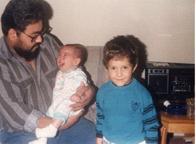 One of al-Qaeda's earliest digital pioneers who lived in California and helped recruit Adam Gadahn, al-Qaeda's prominent American spokesman, was profiled in a digital “book of martyrs” released by the group in January, 2008, celebrating the martyrdom of 120 mujahideen killed in Afghanistan.
Khalil bin Saeed al-Deek, also known as Abu 'Aa'id al-Filistini, received an encomium from al-Qaeda, who praised him in this book of martyrs for his dedication to jihad and the assistance he provided to Al-Deek, who had close ties to al-Qaeda leader Abu Zubaydah, is perhaps most famous for digitizing the Encyclopedia of Jihad, a now widely distributed terrorist training manual produced by al-Qaeda, and providing this manual to Raed Hijazi, one of the operatives involved in the miillennium plot to destroy targets in Jordan in early 2000. Al-Deek was rumored to have been killed in Pakistan in 2005, but his profile in the book of martyrs is the first acknowledgment of his death by al-Qaeda and serves as public confirmation from the group itself that al-Deek was indeed a member of the terror group.
One of al-Qaeda's earliest digital pioneers who lived in California and helped recruit Adam Gadahn, al-Qaeda's prominent American spokesman, was profiled in a digital “book of martyrs” released by the group in January, 2008, celebrating the martyrdom of 120 mujahideen killed in Afghanistan.
Khalil bin Saeed al-Deek, also known as Abu 'Aa'id al-Filistini, received an encomium from al-Qaeda, who praised him in this book of martyrs for his dedication to jihad and the assistance he provided to Al-Deek, who had close ties to al-Qaeda leader Abu Zubaydah, is perhaps most famous for digitizing the Encyclopedia of Jihad, a now widely distributed terrorist training manual produced by al-Qaeda, and providing this manual to Raed Hijazi, one of the operatives involved in the miillennium plot to destroy targets in Jordan in early 2000. Al-Deek was rumored to have been killed in Pakistan in 2005, but his profile in the book of martyrs is the first acknowledgment of his death by al-Qaeda and serves as public confirmation from the group itself that al-Deek was indeed a member of the terror group.
A Palestinian raised in Jordan, al-Deek eventually traveled to the United States in the early 1980s, where he briefly attended aviation school, according to his biography in the book of martyrs. According to the book of martyrs, he later “gave up aviation and devoted himself to computer engineering. Only a few years later, he became a skilled computer engineer.” Al-Qaeda would later avail itself of al-Deek's computer skills to help the group digitize its Encyclopedia of Jihad as well as distribute al-Qaeda's propaganda.
While in the United States, al-Deek met Abdullah Azzam, the peripatetic jihadist Sheikh who recruited many all over the world to jihad and served as a mentor to Usama bin Laden. Like many others, Azzam's rhetoric and charisma transfixed al-Deek, who subsequently “accompanied him in his comings and goings to the mosques of America, inciting and preaching.” Al-Deek then traveled to Afghanistan, “where he trained and prepared. He attacked and fought on the fields of jihad.”
 With the war in Bosnia raging in the early 1990s, al-Deek, as stated in the book of martyrs, left Afghanistan and “packed his cases and made for that land, its people oppressed, in defense of its innocent honors which were terrorized by the Serb infidels.” The book also notes that he did not remain long in Bosnia before returning to Afghanistan, where he “started a new period of killing and fighting.” After a favorite commander of his was killed, al-Deek then returned to the United States, residing in Anaheim.
With the war in Bosnia raging in the early 1990s, al-Deek, as stated in the book of martyrs, left Afghanistan and “packed his cases and made for that land, its people oppressed, in defense of its innocent honors which were terrorized by the Serb infidels.” The book also notes that he did not remain long in Bosnia before returning to Afghanistan, where he “started a new period of killing and fighting.” After a favorite commander of his was killed, al-Deek then returned to the United States, residing in Anaheim.
Al-Deek built a network of operatives around him in California to assist al-Qaeda, being a valuable asset to the group because of his familiarity with the United States and computer skills. Indeed, the book of martyrs notes that al-Deek used “his mastery of computer science in calling and preaching [and] spreading military sciences via the Internet.” By 1997, al-Deek had created one of the first jihadist websites at www.badr.com. The website contained jihadist ideology and rhetoric and remained online through mid-2001.
Also a benefit to al-Qaeda, al-Deek was a naturalized US citizen who had even legally changed his name to the American-sounding “Joseph Adams”. Among those whom he helped recruit while in the United States was a teenage Adam Gadahn, who would later become al-Qaeda's English-speaking spokesman. By 1997, al-Deek was participating in a money-laundering scheme to raise funds for al-Qaeda. Operating a sham non-profit in California called “Charity without Borders,” al-Deek and his cell were able to obtain tens of thousands of dollars from the state of California ostensibly to promote the recycling of motor oil. The names of both Adam Gadahn and al-Deek, as Joseph Adams, appear in likely falsified timesheets required to be submitted to the state to verify the charity's putative activities.

He then left the United States for Pakistan in the late 1990s, where “on the hills of Peshawar, he got married to a Syrian lady, among the people of uprightness and piety, who shared his bitter march.” Utilizing his computer skills, al-Deek was tasked with digitizing the Encyclopedia of Jihad, a manual of thousands of pages educating jihadists on everything from how to make bombs to providing first aid, which al-Deek put on CD-ROM. He also, according to the book of martyrs, “undertook another great effort, in which Allah preserved the heritage of the martyr Imam Abdullah Azzam. He downloaded [Azzam's] recorded speeches, put them on computer discs, and disseminated them.”
In 1999, Raed Hijazi and Khadr Abu Hoshar, plotters of the Millennium attacks to occur in Jordan in 2000, contacted al-Deek and received a copy of the Encyclopedia of Jihad on a CD-ROM. Al-Deek and Abu Hoshar further assisted Hijazi in traveling to Afghanistan to receive military training in preparation for the attacks. However, before the Millennium plot could be carried out, Jordanian authorities arrested many members of the cell, disrupting the attack. With several of the plotters in custody, the Jordanians managed to locate and arrest al-Deek in Peshawar, Pakistan, in January, 2000.
After being taken into custody in Pakistan, al-Deek was extradited to Jordan and was, as stated in the book, “delivered to the kingdom of evil Jordan where he received in Zionist-Crusader prisons what only Allah knows...” While in prison, authorities determined that al-Deek had shared a bank account in Peshawar with Abu Zubaydah, the al-Qaeda lieutenant captured by the United States in 2002 who was the mastermind behind the Millennium plot.
As a result of his imprisonment, the book of martyrs noted that “his soul could not bear staying under the whip of humiliation, amongst the sections of cells. Therefore, he went on a hunger strike.” Al-Deek's hunger strike notwithstanding, the Jordanians eventually released him in May, 2001, due to a lack of evidence. After his release, the book of martyrs recounts that al-Deek “then settled, after many countries refused to receive him, in Lebanon, where he resumed his bloody solitary journey.”
Leaving Jordan, al-Deek was reportedly denied entry to Dubai before traveling to Beirut. After his stopover in Lebanon, al-Deek went again to Peshawar. after residing in Peshawar for several months, “the Pakistani intelligence men knocked on the door of his house and asked him to check-in with the American embassy. There in its departments of evil, he was informed that the Israeli Mossad wanted to meet him.”
As often appears in the trope of jihadist stories, the book of martyrs asserts that al-Deek had a dream vision warning him that his visit to the embassy was dangerous and he was being hunted by intelligence agencies. He therefore, “packed his cases, and escaped with his faith, heading to the battlefields of those garrisoned there around Kabul.”
Fellow mujahideen in Afghanistan praised al-Deek for his intelligence, military prowess, and devotion to God. One jihadist in the book of martyrs, Uthman al-Shahri, stated that al-Deek “loved military training. He was one of the best brothers in computer science. He memorized many parts of the book of Allah. He had extensive ideas and promising prospects [and was] skillful in use of artillery.”
After 9/11, al-Deek remained in Kandahar and fought coalition troops. The book of martyrs recalls, “Only a few weeks after that evident conquest [9/11], the Roman armies came with their horses and knights. Their planes spread fire and terror on earth. The children of tawhid [monotheism] stood up to defend the great Islam. Our martyr [al-Deek] participated with them in that honor. He often spent lengthy nights garrisoned on the gates of Kandahar with the remaining migrant groups...Fifty days of patience and sacrifice, blood, and body parts, [and] Kandahar lost its keys.”
Following the fall of the Taliban in Kandahar, al-Deek fled to the Shah-i-Kot valley in Paktia province. “From there,” the book of martyrs states, “he continued the march of toil and sacrifice and landed in the midst of the Pashtun tribes who, with open arms, welcomed the coming of the children of the companions and the grandchildren of Muhammad.” Undiscouraged, the book notes, “the lion marched in his electric path, undeterred by difficulties. Rather, he became even more active in his preaching, inciting, and preparing.”
 The book of martyrs asserts in hyperbolic fashion that al-Deek's intense support to the jihad became intolerable to the United States, who began the orchestration of his death through the Pakistani government. The book maintains, “The American intelligence became aware of that activity. It could only delegate its tails in Pakistan to get rid of this towering mountain.”
The book of martyrs asserts in hyperbolic fashion that al-Deek's intense support to the jihad became intolerable to the United States, who began the orchestration of his death through the Pakistani government. The book maintains, “The American intelligence became aware of that activity. It could only delegate its tails in Pakistan to get rid of this towering mountain.”
In April 2005, al-Deek's wife reportedly told one of his brothers that al-Deek had been killed. No details surrounding his death have been publicly reported, save for the description of his death in the book of martyrs. The book alleges that that Pakistani intelligence recruited a “traitor agent” who was under al-Deek's command for several months. This agent invited al-Deek to lunch and “in a moment of distraction, that coward pulled [al-Deek's] weapon and fired the bullets of his malice and treason into the body of his guest.” The book laments that “there, under the ceiling of that sad house, the knight of Palestine parted. He courageously dismounted his horse after he performed his duty in this life.”
